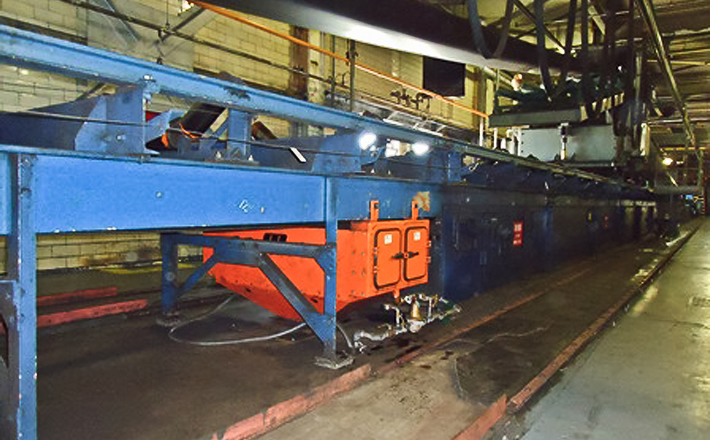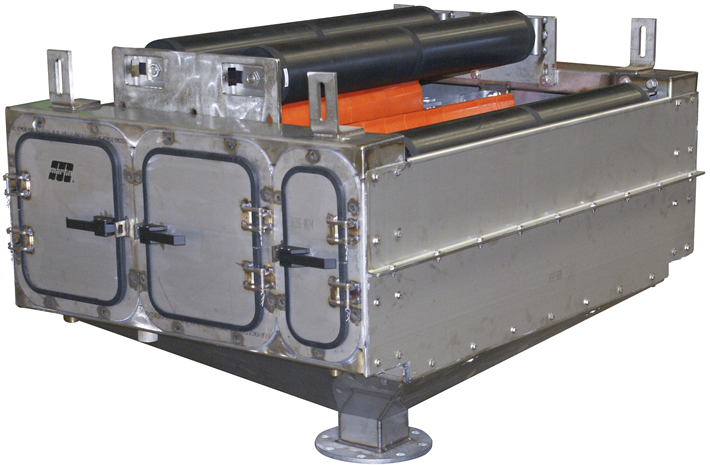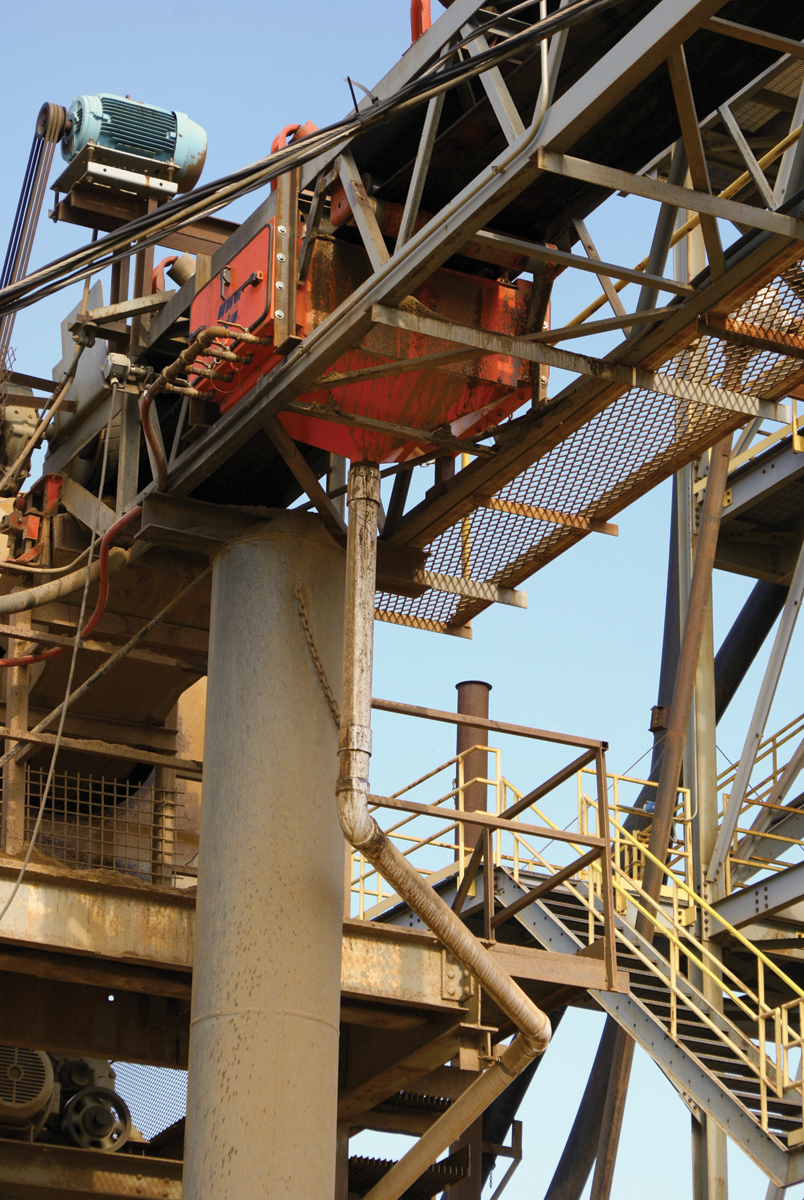Martin Engineering Introduces Washbox™ Cleaning System
Publicado: June 10th 2016
Washbox Conveyor Belt Cleaner Removes Difficult Carryback

[Neponset, IL] – A world leader in conveyor belt cleaning solutions has introduced a secondary cleaning system that removes nearly all of the carryback left on a belt, including adhesive materials and fines lodged in surface divots and valleys. The Martin® Washbox™ Cleaning System combines water spray and secondary cleaning blades in an enclosed and self-contained unit, draining residue safely away from the work area. Operators who have installed the system have drastically reduced dust and spillage from carryback, leading to a safer workplace and longer belt life with considerably less downtime.
“We design systems to eliminate nearly all carryback issues faced by every industry we serve,” said Dan Marshall, Product Engineer at Martin Engineering. “After extensive before and after testing, we developed the Martin® Washbox™ Cleaning System to complement our standard products in some applications to further improve the life of the belts, idlers, pulleys and cleaning blades.”
In operations conveying solid material, normal belt wear can yield valleys and depressions on the belt. Dust and fines that get into these blemishes remain after passing under primary and secondary belt cleaning blades, and become dislodged by shaking from return idlers, causing excessive dust and spillage. Water makes bulk material easier to remove by softening it, keeping the cleaner blades free from buildup and extending blade life by minimizing thermal breakdown due to frictional forces.
Integrated System

Available in two configurations, a Martin® Washbox™ Dual Cleaning System and a Martin® Washbox™ Single Cleaning System, the units are mounted on the conveyor frame directly after the return idler to ensure belt alignment throughout the cleaning process and to allow
proper time for moisture evaporation on the return trip. Passing through a powder coated steel box with top rollers, the belt is gently washed by spray bars equipped with 10 to 30 nozzles delivering 5 to 60 psi (.34 to 4.14 bar) of pressure, using 5 to 54 gpm (20 to 204 L/min) of potable or non-potable water. The belt is then scraped clean by a polyurethane blade and/or a urethane squeegee blade, set on a tensioner for a tight and consistent blade-to-belt seal. Residue drains safely through an outlet funnel below the box, which can lead to a disposal unit or a settling pond/vessel for introduction of material back into the process.
Built for heavy to medium duty applications, the Martin® Washbox™ Dual Cleaning System is equipped with 3 rollers, 4 spray bars, 2 Martin® Inspection Doors and 2 polyurethane secondary cleaners. Recommended for use behind a primary cleaner on the face of the head pulley, the color-coded, high-performance urethane secondary cleaners can be specified for acidic or high-temperature materials. Optional tungsten carbide or stainless steel tips increase the effectiveness and durability of the blade against difficult or rocky carryback. The cleaner system can be specified from 30 - 60 inches (762 – 1524 mm) in length and 44.4 to 53 inches (1129 to 1350 mm) in height, and fits on most conveyor frames by adding approximately 17 inches (432 mm) to belt widths of 18 to 84 inches (457 to 2133.6 mm).
The Martin® Washbox™ Single Cleaning System houses a roller, a secondary blade and a spray bar, which are accessed by an inspection door housed on either side of the enclosure. Intended for tight-fitting spaces on light to medium duty applications, the compact unit is 15 inches (381 mm) long and can be specified from 34 to 42.2 inches (864 to 1072 mm) in height. The total width of the unit can be determined by adding 17 inches (432 mm) to the belt width of 18 to 48 inches (457 to 1219 mm). Recommended for use in tandem with a pre-cleaner, operators have found these units work well for both indoor and outdoor applications where walkways need to be kept free of clutter and pooling.
Operators concerned with the amount of moisture remaining on the belt have the option of adding a squeegee roller, which has proven to effectively address wet carryback. Set between top rollers, it lifts the belt slightly and “flattens” the layer of water on the surface from an average of 50 microns in thickness to 20 microns. This allows the water to better evaporate during its return, particularly on shorter conveyors.
Field Tested

Although the Martin® Washbox™ Cleaning System has been proven in a variety of different industries, one of the more challenging field tests was conducted on a coal-fired energy plant located in Michigan. According to the senior plant engineer, the company had switched to PRB coal, a more brittle and dustier product than the previous coal for which the existing cleaning components had originally been intended.
Operators were seeing excessive dust build-up from carryback on the largest conveyor. The utility used belt scrapers, brush cleaners and dust seals at various points on the conveyors, but the equipment was not adequately addressing the carryback from the new material. This resulted in hours of removal by workers sweeping, shoveling, vacuuming and/or washing down the affected areas on a daily basis, drastically increasing the cost of operation.
Martin Engineering was invited to come up with a solution. Representatives first took benchmark dust readings and found that the 42-inch wide belt, moving 817 tph (732 metric tph) of coal at a belt speed of 475 fpm (145 m/min) resulted in an estimated dry weight carryback of more than 20 tons of coal dust per year. By adding a primary cleaner on the head pulley and aMartin® Washbox™ Dual Cleaning System, the utility experienced a 99% reduction in estimated carryback over the test period. As a result, carryback now accounts for less than a hardhat’s worth of coal dust per day. Operators noticed that visible airborne dust had been virtually eliminated and cleanup frequency was reduced to once per week, pointing out that the unit paid for itself even before the conclusion of the test period.
“Our goal is to help facilities exceed environmental and safety workplace standards,” Marshall said. “By engineering a self-contained and sealed unit with simple working components that are easy to access and maintain, we have created a solution that could benefit nearly all of our bulk handling customers.”